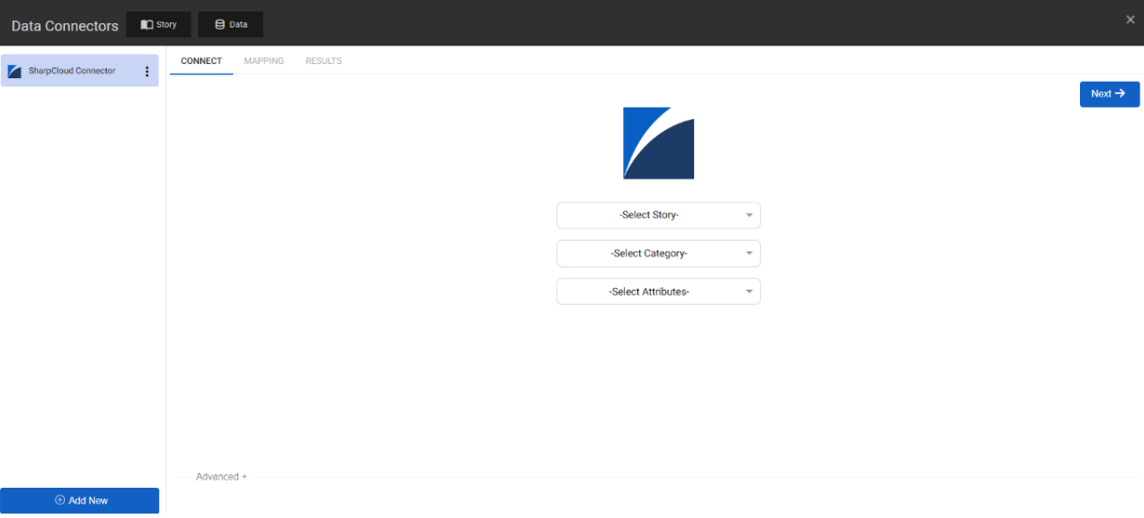SharpCloud Connector
Authentication Methods
It requires no authentication as you are already logged into SharpCloud and not accessing a 3rd party platform.
Typical use-cases
The SharpCloud connector allows you to create and update items on data in other SharpCloud stories, making it easier to move data between stories. You will need to have view access to the story you are pulling data from, and admin access to the story you are pushing the data into.
How to Use the Connector
Once you have created a SharpCloud connector, you will be presented with the “Connect” screen (which is standard for all connectors). This is where you will select a story as shown:

You can choose the story that you would like to utilize via the ‘Select Story’ drop down menu as shown:
.png?width=1144&height=516&name=SharpCloud-Connector(1).png)
Tip: The drop down menu lists recently viewed stories first, so if you are looking for a story, simply open it from your SharpCloud dashboard. When you return to the SharpCloud connector, this story will be the first option in the drop down list.
Once the story is selected, you can select the categories and attributes you want to push through using the further drop down menus. You can select multiple categories at once.
Note: Any attribute selected will be pulled from all categories selected. If you want to pull separate attributes within different categories you will have to run multiple connectors.
You can now press “Next” to move to the mapping section of the connector, where you will select which category you want to import the data into and map the fields in the SharpCloud story you are pulling from to the story you are currently in.
You can view the Source Data, which is the data from the story you are pulling from, and how SharpCloud reads this by clicking on the “View Source Data” button.
.png?width=1144&height=517&name=SharpCloud-Connector(2).png)
You can see we are bringing in the “Items” from the external SharpCloud story and importing them into the “Projects” Category.
You need to nominate an External ID (a unique identifier for each item) in the “External ID” column.
It is a lot better to include an External ID field in the story you are pulling from and nominate that field as the External ID to avoid incorrect data mapping/loss.
For the other fields, you can either map the column to existing attributes in your story or by selecting “(NEW)” which will create a new attribute/property in your story and you can select its type.
.png?width=1144&height=517&name=SharpCloud-Connector(2).png)
Note: For Tag Groups and Categories, these will need to pre-exist before mapping onto those fields – you can access the Story Setup to perform those actions from the top of the screen.
Note: There are some limitations on the data that is being brought through. Tags can only be brought through if they are part of a tag group. If you are using a related to value as seen above, the item the data is related to has to have an external ID, otherwise it won’t come through to the new SharpCloud story.
You can provide a filter on the incoming items, for example, to only create items with a “Priority" value of “High” by using the dropdown on the far right as shown below:
.png?width=1144&height=507&name=SharpCloud-Connector(4).png)
For more advanced actions and queries, you can access the underlying SQL queries to discover and edit how you wish the data to be imported and perform special functions such as JOIN. To access the SQL, simple use the toggle in the top left that says “Show Advanced SQL”:
.png?width=1144&height=512&name=SharpCloud-Connector(5).png)
Note: Once you edit the SQL, you will not be able to return to the dropdown version of the mapping as there are SQL functions that can be performed here that are not accommodated in the dropdown
version.
Once you are happy with the mappings/SQL, press Next to show a preview of what items are going to be created and the additional information:
.png?width=1144&height=513&name=SharpCloud-Connector(6).png)
You can see the rows in blue are new items that will be created if you click the synchronise button. Modified values/cells (where the item value is different from the source data and SharpCloud) will be shown in orange.
Synchronise: Press this button to actually commit the changes to the SharpCloud story. If the commit is successful it will show a summary of the changes made.
Delete Records from story (Default = true): The default setting for this option is true which means deleted records from your data source (Sharpcloud story in this case) will be also be deleted in SharpCloud. E.g. if your data source contains records for items A, B and C, and later the data source only contains A and C, item B will be deleted from SharpCloud.
When you are happy that your connector is transferring the right data in the right way, you can "Publish” it. A published connector cannot be edited anymore, and can be run by anyone who has admin access to the story.
Note: The credentials of the user who published the connector are used to read from the data source and update the story.
Once a connector is published it can be batched to run automatically on and hourly or daily schedule. This is not possible with Excel File connector but is available for other types of connector such as the SharpCloud connector.
.jpg?width=300&name=Website_GeneralCTA.v2(optimized).jpg)
Contact our expert team
Whether it's to discuss functionality, your subscription, or anything else, we strive to give you the best guidance.
Get in touch